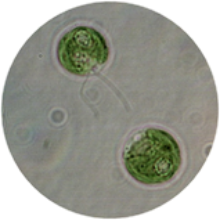Microalgae are unicellular organisms which measure mostly several micrometers in diameter and are found in freshwater or seawater. They are photoautotroph, which means that they can produce energy through the usage of sun light. Thus they show phototactic orientation to light.
Some microalgae, e.g. the marine coccolithophorid Emiliania (E.) huxleyi, cover themselves with elaborated finely-pattered calcite disks, called coccoliths. Coccoliths are produced inside the cell under genetic control through biomineralization processes. The ions needed for the formation of the coccoliths are transported from the surrounding medium into the cell. We modify and tailor the culture conditions of the microalgae regarding the incorporation of other elements of interest like zinc or terbium, a rare-earth-element, which shows photoluminescence. The elaborated micro- and nanostructure of the coccoliths is retained, even after incorporation of these elements. Due to the incorporated terbium the coccoliths show green luminescence, and could be used e.g. for the labeling of important documents or in bioassays. Thus, the algae produce finely-pattered 3D functional materials.
In cooperation with Dr. Lars P.H. Jeurgens and Michael Stiefel, EMPA (Eidgenössische Materialprüfungs- und Forschungsanstalt), in Duebendorf, Swiss
Santomauro, G., Stiefel, M., Jeurgens, L. P. H., & Bill, J. (2020). In Vivo Shaping of Inorganic Functional Devices using Microalgae. Advanced Biosystems, 1900301. https://doi.org/10.1002/adbi.201900301
Santomauro, G., Sun, W.-L., Brümmer, F., & Bill, J. (2016). Incorporation of zinc into the coccoliths of the microalga Emiliania huxleyi. BioMetals, 29(2), 225--234.
Swimming microorganisms have been shown to be useful for the propulsion of microrobotic devices due to their self‐powered motion. In this regard, mainly magnetotactic bacteria have been investigated. We are working with the microalga species Chlamydomonas (C.) reinhardtii, which is able to carry heavy loads. Microalgae are phototactic organisms, which naturally orient to light, but we successfully incorporated terbium, a rare earth element, into C. reinhartdii, thus making the algae magnetotactic. Our magnetotactic microalgae orient to the field lines of an applied and actively swim towards the magnet. Due to this behavior they can be guided in the dark by using a magnet and could e.g. easily be collected. Furthermore, our magnetotactic C. reinhardtii microalgae are biocompatible.
Our ptychography results indicate that the terbium is obviously accumulated in (magnetic) nanoparticles inside the cells. The composition and structure of these nanoparticles is currently investigated.
Naturally microalgae occur together with other microorganisms, e.g. the bacteria Escherichia coli, whose swimming behavior (pusher-type microswimmers) is opposite to the swimming behavior C. reinhartdii (puller-type microswimmers). We investigate, how population of these microswimmers in co-culture interact with each other regarding their swimming behavior.
In cooperation with Dr. A. V. Singh and Prof. M. Sitti, Max-Planck-Institute for Intelligent Systems, Dept. Physical Intelligence, Stuttgart and Dr. B.-W. Park, Department of Civil/Environmental & Chemical Engineering, Youngstown State University,Youngstown, OH 44555, USA and Priv.-Doz. Dr. E. Goering and Prof. G. Schütz, Max-Planck-Institute for Intelligent Systems, Dept. Modern Magnetic Systems, Stuttgart
Singh, A. V., Kishore, V., Santomauro, G., Yasa, O., Bill, J., & Sitti, M. (2020). Mechanical Coupling of Puller and Pusher Active Microswimmers Influences Motility. Langmuir, 36(19), 5435--5443. https://doi.org/10.1021/acs.langmuir.9b03665
Singh, A. V., Laux, P., Luch, A., Sudrik, C., Wiehr, S., Wild, A.-M., Santomauro, G., Bill, J., & Sitti, M. (2019). Review of emerging concepts in nanotoxicology: Opportunities and challenges for safer nanomaterial design. Toxicology Mechanisms and Methods, 29(5), 378--387.
Santomauro, G., Singh, A. V., Park, B.-W., Mohammadrahimi, M., Erkoc, P., Goering, E., Schütz, G., Sitti, M., & Bill, J. (2018). Incorporation of terbium into a microalga leads to magnetotactic swimmers. Advanced Biosystems, 2(12), 1800039.

Giulia Santomauro
Dr.Groupleader






